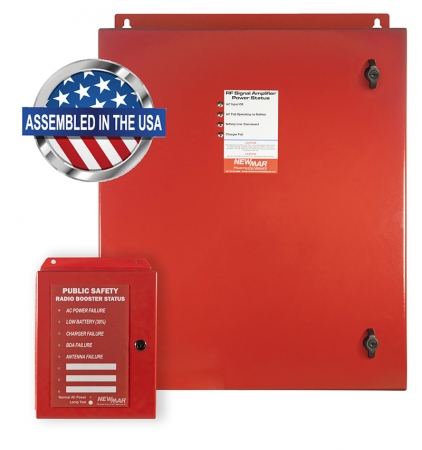
Choosing a Battery Backup Solution for public safety communications
Written by Jeff Patrick, Director of Product Development, Newmar
Communication systems are critical for ensuring public safety, but they are not enough on their own. Without steady power running to distributed antenna systems (DAS), bi-directional amplifiers (BDA), and repeaters, life and property are put at risk.
Whether by a natural disaster, mechanical breakdown, or other emergency, utility failures happen. When the grid goes down, it is crucial to be prepared with a battery backup solution to keep critical communication systems online.
To choose the best battery backup solution for the application it is crucial to know the requirements, select the appropriate features, and choose an expert manufacturer.
Know your requirements
Input and output voltage
The main component in an AC or DC backup power system is the uninterruptible power supply (UPS) unit. The first step to choosing the power supply is determining the application’s input and output voltage requirements.
Outputs for DC applications will be +12, +24, or -48V, and AC applications are generally 120VAC. The input voltage requirements will vary broadly, so ensure your DC or AC UPS has an input voltage range to accommodate fluctuations. Newmar Power offers a variety of DC and AC backup power solutions with a wide input voltage acceptance.
Transfers and surges
For AC systems, quick transfer time between the utility and backup power is another non-negotiable feature and should never go above 25 milliseconds. DC systems place the battery, power supply, and load in parallel, so there is no actual transfer time; this is sometimes called a transparent switch-over.
It is also critical to understand the surge capacity. Many backup power system manufacturers claim surge capacity at double the continuous output, but the key question is: for how long? The Newmar AC UPS has a surge rating of 2 x continuous output for 5 seconds or more. If a manufacturer doesn’t specify the duration of the power surge, it should raise a red flag.
Batteries and run time
Batteries are the next major component in a backup power solution. Sealed valve-regulated lead-acid (SVRLA), absorb glass mat (AGM) type, or sealed gel batteries are common choices for backup power systems because of the relatively reasonable price point and 5 to 7-year life expectancy (in controlled environments). However, NiCad or lithium-ion batteries may also be suitable and have pros such as extended life expectancy, higher energy density, and operability in higher temperatures; however, these features come at a cost – usually a significantly higher price point. If NiCad or lithium-ion batteries are being considered, ensure the UPS unit is compatible.
Battery size is determined by the required backup power run time. Different applications and system set-ups will require different run times. For example, a large stadium or hospital with emergency generators only needs backup power to run for a few minutes, just long enough for generators to come online. Conversely, a remote site in an unpopulated area may need up to 24 hours of backup power.
The run time may also be established and/or enforced by the local Authority Having Jurisdiction (AHJ). Understand your application and local mandates to determine the appropriate run time and the corresponding battery bank capacity in terms of amp-hours required. It is also best to consult the battery manufacturers’ run time charts for 'amps or watts to final voltage' for the most accurate run times; also, remember these run times are at best case 25°C room temperature.
Power and sizing
Once the amp hours, load current, and voltage for the application are determined, size up. Most backup power solutions are not designed to be upgraded, so plan for expansion and choose a backup power solution that will continue to meet the needs of the application a few years down the road.
For example, a typical 20 story commercial office building with a standard DAS system may consume 1200 W of power.
To account for any future upgrades or additions to the load, add 15% to the current power requirements for a 1380 W system. In this scenario, a Newmar Power AC-UPS-48-2000 with its 1600W continuous output would be ideal. The growth constant should also apply to the batteries which account for the gradual loss of capacity due to age and cycle life reduction.
Another aspect to consider when specifying a backup power solution is installation. Choose a system that is lightweight and simple enough to be installed by a single person. Physical size should also be considered, especially when the installation site is limited on space.
Select features
Alarms and sensors
When it comes to powering critical communication systems, don’t skimp on the feature set. A UPS or charger/rectifier with a temperature compensated charging sensor option should be employed whenever the system will be installed in an outdoor cabinet or environmentally uncontrolled indoor space.
The National Fire Protection Association (NPFA) determines many requirements for public safety equipment. NPFA’s code 1221, the Standard for the Installation, Maintenance, and Use of Emergency Services Communications Systems, requires backup power systems to include a variety of alarms: AC failure, rectifier failure, and low battery; Newmar’s DC backup power systems have all three of these alarms built-in. Ensure your backup power system includes any required alarms or contacts to implement them.
Install location
Some applications require installation in an outdoor or uncontrolled indoor environment which will require the power supply to be rated as such. In some instances, an enclosure may also be appropriate.
Know your installation location and seasonal ambient temperature extremes where the equipment will be installed. For outdoor installs, a NEMA 3R is common and allows filtered forced air cooling. In extreme environments, an enclosure employing environmental controls such as heat exchangers, air conditioning, or thermoelectric coolers may be appropriate.
Backup power system enclosures specific to public safety DAS applications are generally regulated by the following standards:
-
• NFPA 1221: Standard for the Installation, Maintenance, and Use of Emergency Services Communications Systems
-
• UL50E: Standard for Safety Enclosures for Electrical Equipment, Environmental Considerations
-
• NEMA Type 4: Weather-tight enclosures for protection from dirt, rain, sleet, snow, dust, splashing water, and hose-directed water.
In addition to AHJ standard compliance, proper ventilation on weather-tight enclosures is imperative. Without ventilation, the system is at risk for a myriad of issues including fire and even explosion. Ensure the enclosure meets the demands of the application and includes the necessary features to allow the system to function smoothly and safely.
DOWNLOAD DATA SHEET
Choose an Expert
Critical applications require products made by experts in the field of power solutions. Choose a backup power solutions manufacturer with many years of experience and a solid reputation for quality products. Manufacturers should show a thorough understanding of AHJ regulations and public safety applications.
Access to technical support is also key to implementing a reliable battery backup system. Ensure the manufacturer is reachable and responsive in the event technical support is required.
Newmar has over 50 years of manufacturing DC and AC power solutions and is known for high-quality products and reliable customer support. To learn more about Newmar’s battery backup solutions, visit www.poweringthenetwork.com.

About the Author:
Jeff Patrick boasts over 40 years of experience in the telecom and marine power industries, from manufacturing and technical support to design engineering and product development. Patrick is responsible for the design of Newmar’s public safety-oriented battery backup units and leads Newmar’s engineering team as Director of Product Development.
